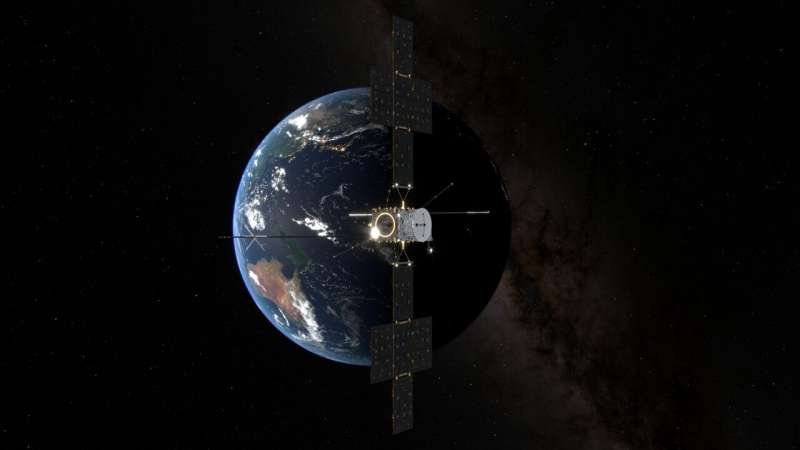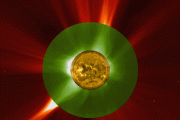
Copernical Team
Newly discovered moon cave could house future lunar explorers, researchers say
 New findings published Monday suggest a recently discovered cave on the moon could be a good place for future explorers to find shelter from outside elements in a possible base location, according to Italian researchers.
"These caves have been theorized for over 50 years, but it is the first time ever that we have demonstrated their existence," Lorenzo Bruzzone, professor at the Univers
New findings published Monday suggest a recently discovered cave on the moon could be a good place for future explorers to find shelter from outside elements in a possible base location, according to Italian researchers.
"These caves have been theorized for over 50 years, but it is the first time ever that we have demonstrated their existence," Lorenzo Bruzzone, professor at the Univers NASA events commemorate 55th anniversary of Apollo 11 moon landing
 NASA is recognizing the 55th anniversary of the Apollo moon landing this month with a variety of events and engagements that started on Monday.
Apollo 11 landed on the moon on July 20, 1969, and its celebration will highlight NASA's current effort to return to the moon for long-term exploration with the Artemis mission. The Artemis mission is expected to land the first woman and first p
NASA is recognizing the 55th anniversary of the Apollo moon landing this month with a variety of events and engagements that started on Monday.
Apollo 11 landed on the moon on July 20, 1969, and its celebration will highlight NASA's current effort to return to the moon for long-term exploration with the Artemis mission. The Artemis mission is expected to land the first woman and first p Juice's Historic Lunar-Earth Flyby: Key Details
 Juice is set to achieve a remarkable milestone with its unprecedented lunar-Earth flyby, the first of its kind. This double gravity assist maneuver is critical for adjusting the spacecraft's trajectory, but it is a complex and high-risk operation.
Since Juice's launch in April 2023, this flyby marks the beginning of its intricate journey towards Jupiter. Earth's gravity will redirect Juice
Juice is set to achieve a remarkable milestone with its unprecedented lunar-Earth flyby, the first of its kind. This double gravity assist maneuver is critical for adjusting the spacecraft's trajectory, but it is a complex and high-risk operation.
Since Juice's launch in April 2023, this flyby marks the beginning of its intricate journey towards Jupiter. Earth's gravity will redirect Juice Innovative Stochastic Model Revolutionizes Interplanetary Supply Chain Planning
 The Beijing Institute of Technology has unveiled a groundbreaking study that seeks to reshape how we plan and manage supply chains between Earth and Mars. Using a Multi-Stage Stochastic Programming (MSP) model, the researchers have addressed the complex uncertainties inherent in interplanetary logistics, providing fresh insights into the infrastructure and operational requirements for supporting
The Beijing Institute of Technology has unveiled a groundbreaking study that seeks to reshape how we plan and manage supply chains between Earth and Mars. Using a Multi-Stage Stochastic Programming (MSP) model, the researchers have addressed the complex uncertainties inherent in interplanetary logistics, providing fresh insights into the infrastructure and operational requirements for supporting China's All-Electric Communication Satellite APSTAR 6E Now Operational
 China's first fully electric communication satellite, APSTAR 6E, officially commenced operation on Monday, announced China Great Wall Industry, the project's contractor.
Launched by a Long March 2C rocket from the Xichang Satellite Launch Center in Sichuan province in January 2023, APSTAR 6E took 514 days to transition from a low-Earth orbit, where it was deployed, to its designated geosyn
China's first fully electric communication satellite, APSTAR 6E, officially commenced operation on Monday, announced China Great Wall Industry, the project's contractor.
Launched by a Long March 2C rocket from the Xichang Satellite Launch Center in Sichuan province in January 2023, APSTAR 6E took 514 days to transition from a low-Earth orbit, where it was deployed, to its designated geosyn Next-Gen Weather Satellite Completes Critical Environmental Tests
 As climate change drives more frequent and severe weather events, the importance of precise and timely forecasting has grown immensely. The upcoming Meteosat Third Generation weather satellite has successfully completed its environmental testing, marking a significant milestone on its path to launch.
This new series of satellites aims to revolutionize weather forecasting, particularly acro
As climate change drives more frequent and severe weather events, the importance of precise and timely forecasting has grown immensely. The upcoming Meteosat Third Generation weather satellite has successfully completed its environmental testing, marking a significant milestone on its path to launch.
This new series of satellites aims to revolutionize weather forecasting, particularly acro Existence of Lunar Lava Tube Confirmed by International Scientists
 A team of international scientists, led by the University of Trento, Italy, has made a major discovery about the Moon. For the first time, they have confirmed the existence of a tunnel in the lunar subsurface, likely an empty lava tube. This significant research, published in Nature Astronomy, is the result of an international collaboration.
"These caves have been theorized for over 50 yea
A team of international scientists, led by the University of Trento, Italy, has made a major discovery about the Moon. For the first time, they have confirmed the existence of a tunnel in the lunar subsurface, likely an empty lava tube. This significant research, published in Nature Astronomy, is the result of an international collaboration.
"These caves have been theorized for over 50 yea XMM-Newton shows million-degree gas in Abell 2390
 Image:
XMM-Newton and Euclid image of galaxy cluster Abell 2390
Image:
XMM-Newton and Euclid image of galaxy cluster Abell 2390 Introducing Ramses, ESA’s mission to asteroid Apophis

30 years ago, on 16 July 1994, astronomers watched in awe as the first of many pieces of the Shoemaker-Levy 9 comet slammed into Jupiter with incredible force. The event sparked intense interest in the field of planetary defence as people asked: “Could we do anything to prevent this happening to Earth?”
Juice's lunar-Earth flyby: All you need to know

ESA's Jupiter Icy Moons Explorer (Juice) will return to Earth on 19–20 August, with flight controllers guiding the spacecraft first past the moon and then past Earth itself. This "braking" maneuver will take Juice on a shortcut to Jupiter via Venus.
What is happening?
It's a double world first. The first-ever lunar-Earth flyby, and the first-ever double gravity assist maneuver. It will change Juice's speed and direction to alter its course through space, but it's a daring feat; the slightest mistake could take Juice off course and spell the end of the mission.
Following Juice's launch in April 2023, this lunar-Earth flyby is the first step in the spacecraft's waltz through the solar system on its journey to Jupiter.
During the flyby, Earth will bend Juice's trajectory through space, "braking" it and redirecting it on course for a flyby of Venus in August 2025.
































